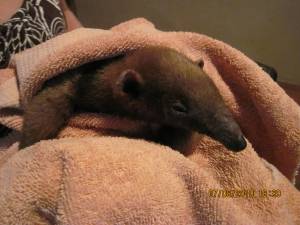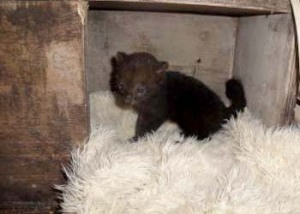Everyone, please give a warm welcome to the newest rescue, Antonio the anteater. He is a tamandua which is a medium sized anteater who lives both in the trees and on the ground. We dont know too much about him. He was being sold on the side of the road and was rescued by a nice couple who knew that he would be better off here. Isn’t he a cutie?
Welcome Antonio!
9 07 2010Comments : 1 Comment »
Tags: anteater, anteater as a pet, baby animal, baby anteater, pet anteater, pet poaching, poach, rescued anteater, roadside pet sales
Categories : Uncategorized
Jaguarundi Kitten Learns to Hunt
22 05 2010About a month ago Paradise Gardens received a baby jaguarundi. He had been found by a farmer in a field. The cub’s den had been run over by a tractor and it appeared that the mother had escaped with the other cubs (there are one to four cubs in a litter) but had been unable to carry them all and left this one behind. The farmer waited, watching the baby to see if the mother might return and protecting the baby from other possible predators in the interim. The mother never returned, and the farmer collected the cub and brought him to us to care for.
He arrived so tiny he had to be bottle fed. We had to make a decision quickly though: was he going to be released or would he be staying with us at Paradise Gardens for the rest of his life? Obviously it would be best for him and us if he could be released. He had arrived to us very young and with very little human contact, no injuries and no sickness. He could be released.
For a successful release we must minimize his contact with humans. Big cats are tricky because if he will stay his human contact must be maximized but for a cat in the wild to be comfortable with humans is a death sentence. Jaguarundis are smallish versions of the well-known big cats, slightly smaller than an ocelot. Yet they are still considered a danger to humans.If a cat is released after having too much human contact he or she will approach humans for attention (think of a cat purring and weaving around your legs… now imagine a big, wild cat doing that) or food and probably be killed or injured. Cats that have to remain here and will never be released, on the other hand, have to have loads of human attention and interaction. Lottie, the margay (looks similar to an ocelot), arrived as a three-month old who had spent her whole life, after being taken from her mother, in a human home. She had been kept in a two-foot by four-foot box, not nearly big enough for her body, and without the proper space her tail had grown kinked. Because she had no muscle tone she was unable to walk on her own. These three factors led Paradise Gardens to decide that she would never be able to be released. Living in such close quarters to humans she had grown accustomed to them. With a kinked tail she would never be able to hunt properly. And she needed a lot of human contact in order to heal her atrophied muscles.
In the case of the jaguarundi, it is impossible to completely cut out human contact. He had to be bottle fed at first and even now putting food into his cage involves brief human contact. However humans do not play with him, talk to him or touch him. He is unavailable for visitors to view. But he has to learn to hunt. And jaguarundis are raised by their parents with their siblings, although they are generally solitary for the rest of their lives. So we gave him some siblings: two house kittens! They have all been eating raw meat and are learning to catch chicks and mice. The kittens trump the jaguarundi at catching the mice but they are cautious of the chicks while the jaguarundi pounces as soon as he notices them.
As for the margay who lives here, she does hunt some. Every now and then a fish from the stream that runs through her enclosure is a nice snack and sometimes even the pigeons that get in are devoured. So maybe not a good enough hunter to be released into the wild but she does better than my house cat.
Comments : Leave a Comment »
Tags: adorable kitten, animals, baby animal, Boquete, boquete travel, Central America, Chiriqui, cute animals, cute kitten, house cat, house kittens, Hunting, jaguarundi diets, kittens, litter mates for wildcats, Margay, mouse hunting, Ocelot, otter cats, otter kittens, Panama, panama visitors, Paradise Gardens, raising wild cat, teaching baby jaguarundi to hunt, the best of boquete, the best of panama, the otter cat, tour boquete, tour panama, travel boquete, travel panama, visit boquete, Volunteer, wild animals, wildcat kittens, wildcats, wildlife rescue, Wildlife Sanctuary
Categories : Uncategorized

